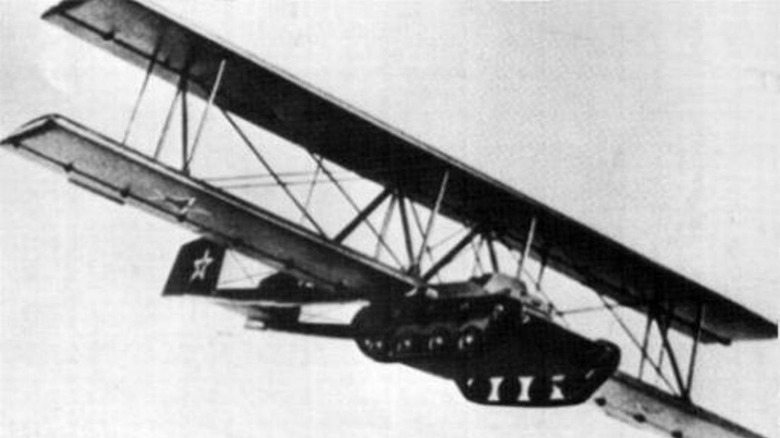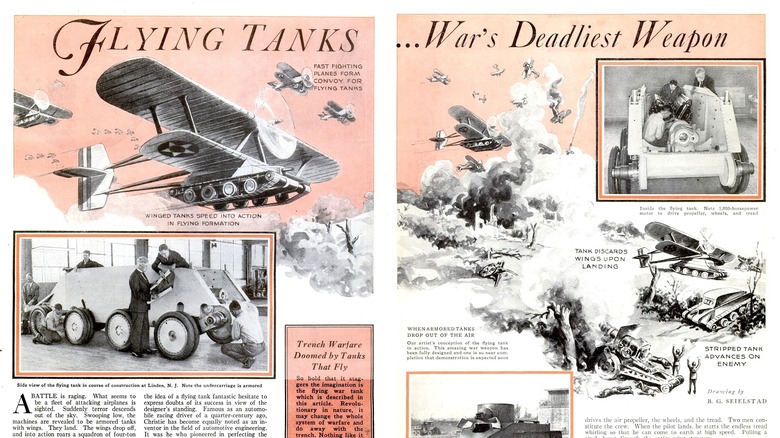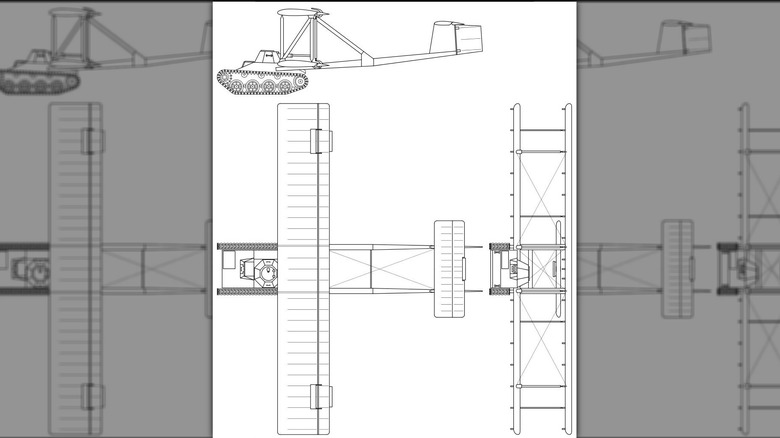The Remarkable Story Of The 1940s Flying Tank
Given Hitler's penchant for the absurd, the idea of flying tanks sounds like something he would have certainly attempted. However, it was actually the Soviets who executed this wild plan, based on plans from American inventor and race car driver John Walter Christie from the early 1930s.
Christie was a self-made engineer who designed several armored fighting vehicles and innovative suspension components for AFVs, most of which never got off the ground. The old proverb that timing is everything was never more appropriate than in Christie's case, who was working during the era when the United States military industry was moving away from the ideas of the individual inventor and transforming into a collective corporate think tank structure.
Between 1916 and 1924, Christie built 15 different AFVs that the U.S. Army Ordinance Department tested and ultimately never used. In 1928, he developed the M1928 high-speed tank, also known as the "Model 1940" (because Christie thought the design was 10+ years ahead of its time). Standard tracks moved it across rough terrain but could be removed to ride on four independently suspended rubber road wheels and reach a top speed of 42.5 mph. The drawback was that it had very thin armor, and the Army also passed on that prototype.
Undaunted, Christie did what any good entrepreneur would do and went overseas, eventually finding buyers for his ideas in England and Russia, with the latter morphing his M1928 concept into its line of BT fast tanks.
[Featured image by Tempshill via Wikimedia Commons | Cropped and scaled | Public Domain]
Look, up in the sky!
By the early 1930s, armies around the globe were trying to figure out how to get troops and tanks onto the battlefield in new and expeditious ways. Dropping AFVs from a plane or via parachute (without a crew) was restrictive due to the tank's operating weight. Overall, the logistics were deemed too complicated and hazardous because the methods typically resulted in the loss or destruction of the tank, the plane dropping it, or both.
Seeing a need, John Walter Christie created blueprints for a flying tank in 1932. A flight control unit consisting of biplane wings, a tail, and a propeller connected directly to the tank's engine would theoretically allow it to fly under its own power "as swiftly as a bombing plane," drop the flight unit after landing, and proceed into battle "with guns blazing at speeds of 70 miles an hour." If pigs could fly, right? The idea never got off the ground (pun intended), but the concept had now been created, and the seed was planted.
Enter Oleg Antonov, a Russian aircraft designer who obsessed over planes as a kid and designed his own glider by the age of 18. That obsession culminated in 1933 when he became the chief designer at the Moscow Glider Factory — only a year after Christie's flying tank idea, which naturally had fascinated the young Antonov.
It took several years for the opportunity to present itself, but in 1940, the Russian army commissioned Antonov to design a glider capable of transporting light tanks into battle.
[Featured image by Benjamin Goodwin Seielstad via Wikimedia Commons | Cropped and scaled | Public Domain]
Build it and they will ... crash?
Oleg Antonov dove into his new assignment and began working on a glider prototype known as the A-40. He thought attaching a pair of biplane wings made of wood and canvas with a big enough span and a long double boom tail would generate enough lift to get a tank off the ground. It didn't take long for Antonov to realize the flaw with the whole concept.
The only viable tank deemed light enough was the T-60, a 6-ton tank with light armament and even thinner armor. According to sources, it was so hated by Russian troops that it was referred to as "a brother's grave for two." Still, Russian military officials thought having any flying tank was better than having no flying tank at all, so they urged Antonov to continue.
In many respects, his design was very similar to Christie's original concept, minus the propeller hook-up. The double-stacked biplane wings had a span comparable to a small bomber's and became an enormous target when coupled with the long tail boom.
However, a complete working prototype wasn't assembled until 1942, and not without some significant caveats. To lighten the test flight load, they decided to strip the T-60 of all of its ammunition and most of its fuel. Although the turret was supposed to control the glider's flight path, they also removed that for good measure.
[Featured image by Kaboldy via Wikimedia Commons | Cropped and scaled | CC BY-SA 3.0]
The flying tank bombed
Without a propeller, how was it supposed to take off? For its only test flight on September 2, 1942, it was attached via tow ropes to a Tupolev TB-3 bomber. Not long into the flight, the bomber's engines started to overheat from the weight and drag of the tank, so it was released early.
Surprisingly, pilot Sergei Anokhin (given a crash course on tank operations) landed the glider successfully in a field. Anokhin detached the flight control unit and drove the tank back to base. While the exercise proved the basic aerodynamic principles worked, the concept wasn't practical. Especially given the end goal was to fly 26-ton T-34s into combat, which were over four times the weight of a T-60.
The Russians ditched the idea, but other countries, including Japan, attempted to tackle the problem. Using a custom-built 2.9-ton tank, the Special Number 3 Light Tank Ku-Ro was meant to be towed behind a hefty cargo plane and released to glide safely to a landing. They couldn't figure out how to keep the tracks from shredding, so they tried using removable skis. That didn't work, and the project was canceled.
The British attempted a version called the Baynes Bat. The tailless Bat featured swept-back V-shaped wings, making it look like a boomerang. The wingspan covered over 100 feet and had vertical stabilizers that acted like tailfins on each end. It never went into production, and the idea of a "flying tank" finally faded into the annals of history.


